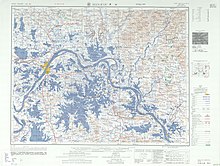Hupeh
Jump to navigation
Jump to search
English[edit]

Etymology[edit]
The Postal Map romanization of Mandarin 湖北 (Húběi).
Pronunciation[edit]
- enPR: ho͞oʹpāʹ
Proper noun[edit]
Hupeh
- (historical or obsolete) Alternative form of Hubei
- 1911, W. H. Wilkinson, Consul-General Wilkinson to Sir J. Jordan (Correspondence Respecting the Disturbances in China)[1], Harrison and Sons, page 51:
- Recent letters show that Wushan and K'uei-fu, towns on the river below Wan Hsien, were still in the hands of the existing Government on the 8th instant, though Li-ch'uan, west of Shihnan-fu, in the extreme corner of Hupeh, was reported to be in the hands of the revolutionaries.
- 1966, David S. Nivison, The Life and Thought of Chang Hsüeh-ch'eng (1738-1801)[2], Stanford University Press, →LCCN, →OCLC, →OL, page 208:
- The magistrate of Ma-ch'eng in Hupeh engaged Chang to compile a local history for his district.
- 1971, “Historical Relic Unearthed During the Cultural Revolution”, in Eastern Horizon[3], volume X, number 5, Hong Kong: Eastern Horizon Press, →ISSN, →OCLC, page 26, column 2:
- A group of bronzes of the late Western Chou were uncovered in Chingshan County, Hupeh Province, and 25 pieces of stone ching (musical chimes) with a painted design of the State of Chu were found in Chiangling County of the same province.
- 1980, KAI-YU HSU, WEN I-TO[4], Twayne Publishers, →ISBN, page 21:
- HSIA-pa-ho Village is a small but rich "fish and rice" village located at the confluence of the Pa and the Yangtze rivers outside the Hsi-shui county seat in Hupeh province.
- 1981, Hualing Nieh Engle, translated by Jane Parish Yang and Linda Lappin, Mulberry and Peach: Two Women of China[5], Boston: Beacon Press, page 17:
- A terrible battle has broken out again in northern Hupeh and western Hunan.
- 1992, Cheng Chien Bhikshu, Sun-Face Buddha: The Teachings of Ma-tsu and the Hung-chou School of Ch'an[7], Berkeley: Asian Humanities Press, →ISBN, page 8:
- At the age of forty Tao-hsin moved to Shuang-feng Mountain in the district of Huang-mei, present-day Hupeh province. There he attracted a large following; it is said that he had five hundred students studying under him.
Descendants[edit]
- Translingual: Hupehsuchus, Agramma hupehanum
References[edit]
- “Hupeh, pn.”, in Lexico, Dictionary.com; Oxford University Press, 2019–2022.
- “Hupeh”, in Merriam-Webster Online Dictionary, Springfield, Mass.: Merriam-Webster, 1996–present.
- “Hupeh” in TheFreeDictionary.com, Huntingdon Valley, Pa.: Farlex, Inc., 2003–2024.